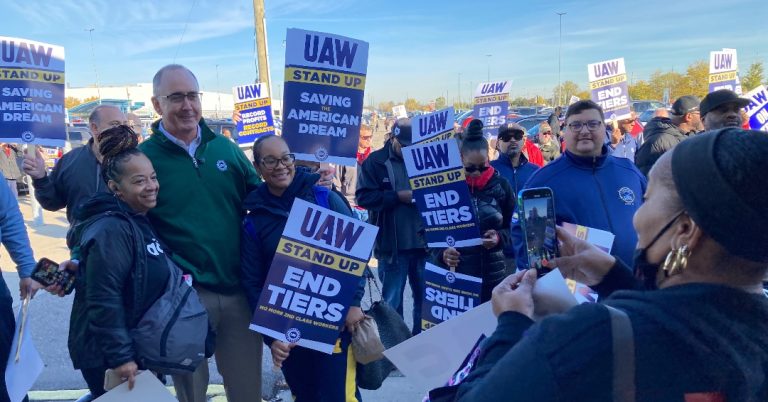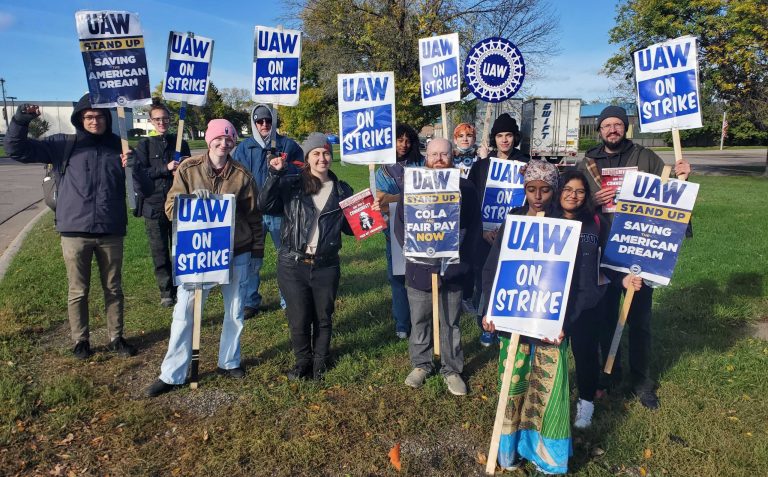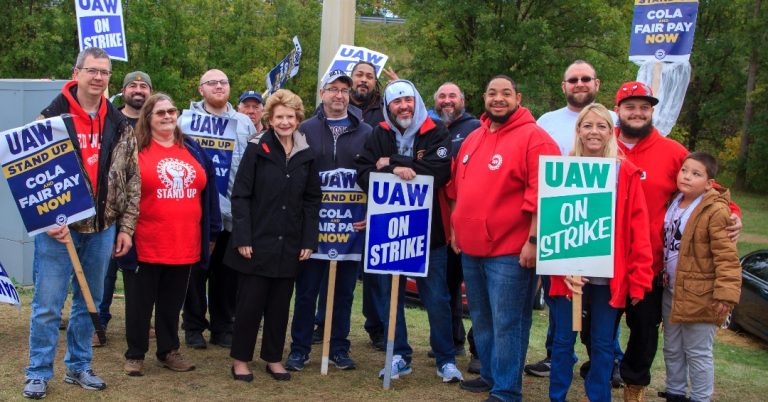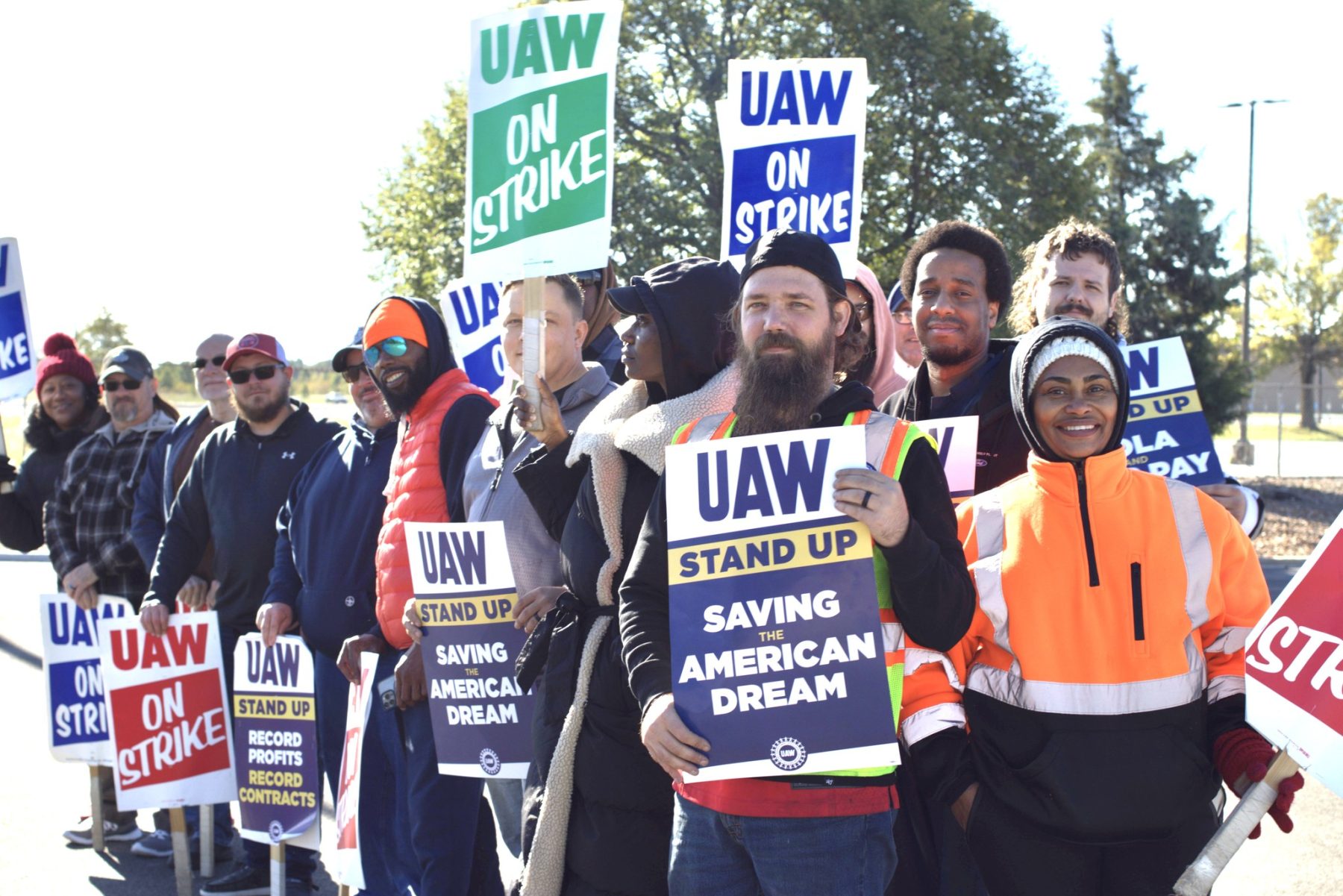The United Auto Workers’ (UAW) contracts with the Big Three automakers—GM, Ford, and Stellantis—all expired on September 15, 2023. Shawn Fain and the new UAW leadership were willing to lead the workers on strike. History shows that workers can win more with a fight than when no struggle is engaged in at all. However, Fain put forward a strategy of the “stand-up” strike, which he argued would be this generation’s answer to the sitdown strikes of the 1930s.
Note: On 17 November, just over 68 percent of UAW members at Ford Motor plants voted to ratify the new deal on contracts described in this article. Support at Stellantis was roughly equal to that for Ford workers. But workers at General Motors returned a vote of 54.7 percent, with a significant layer objecting to the lower wage increases offered to new hires, as well as other issues around pensions and benefits.
[Originally published at socialistrevolution.org]
The original demands included eliminating wage tiers, 40% in wage increases plus cost-of-living adjustments (COLA), and restoring defined benefit pensions to all UAW members. Fain said that the element of surprise would put the bosses on the defensive and force them to give in to the union’s demands. The UAW has now announced tentative agreements with all of the Big Three. As we go to press, more information is available about the Ford agreement than the others, but they are reported to be similar. How did the union leadership’s strategy work out?
The tentative agreements
 Fain argued that the “stand-up” strike would be this generation’s answer to the sitdown strikes of the 1930s / Image: UAW, Facebook
Fain argued that the “stand-up” strike would be this generation’s answer to the sitdown strikes of the 1930s / Image: UAW, Facebook
Fain had explained that the auto executives have received 40% in compensation increases, on top of their large profits, and that he’d fight for the same increase for UAW members. In the end, the workers received just 25% in wage increases, spread out over four years. And although the contracts expired on September 15, the first increase is only retroactive to October 23. This was, at best, a very partial victory that does not make up for lost ground.
The union leaders themselves noted that COLA increases had been established back in 1948, but had been suspended since 2009. However, they did not draw attention to the fact that inflation has been nearly 46% from 2009 to the present. This means that wages have been effectively cut since 2009. And while there will be COLA adjustments in this contract, the formula was not explained. When unions ask for COLA, workers should get a full wage increase every month, based on the Consumer Price Index. Complex formulas are ways of creating the impression that workers will get some compensation, but are their monthly wages really increasing at the same rate as prices?
Furthermore, all UAW members who were previously excluded from the defined benefit pensions are still shut out from that important benefit. They will be given more in company contributions to their 401k accounts, but this amounts to a huge concession to the companies. The 401k schemes put the onus on the workers to save for their own retirement and assume all of the investment risk. This must count as a defeat.
As for the demand to eliminate all tiers, workers clearly remain divided along pension tiers, and wage tiers have been narrowed, but not eliminated. Apparently, two Ford plants had special local wage tiers, and these have been ended at Sterling Axle and Rawsonville. This leaves three wage tiers: temps; the lower-paid permanent workers; and those at the top wage level. The lower permanent workers will now be on that tier for three years and progress to the top tier over that period. The temp workers will take three to nine months, depending on various circumstances, to become permanent and reach the low tier. This division of the workforce, which allows companies to pay different wages to workers performing the same work, works against unity and the whole principle of why unions were established. Another defeat.
The contract continues supplemental unemployment benefits for laid off workers, but it does not prohibit such job cuts. This, at a time when new technology, coupled with expanded production of electric vehicles, creates a situation where more jobs stand to be eliminated by the bosses. In the 1970s, the UAW had more than a million members. Now, the UAW’s active auto membership is less than 160,000. What will that number be when the contract expires in 2028?
 The new contract ends on April 30, 2028. Generally speaking, workers should fight for shorter contracts, especially when they agree to “no-strike” pledges / Image: Socialist Revolution
The new contract ends on April 30, 2028. Generally speaking, workers should fight for shorter contracts, especially when they agree to “no-strike” pledges / Image: Socialist Revolution
The UAW leadership reports they have negotiated a new “right to strike” over plant closures, but no specifics were given. Does this mean that if Ford closes a plant, then the entire Ford UAW membership can go on strike? Or only workers at the closing plant? If only the plant in question is included, how would a strike there gain any leverage, since the company wants to shutter it anyway?
The new contract ends on April 30, 2028, which is 4.5 months less than five years long. Generally speaking, workers should fight for shorter contracts, especially when they agree to “no-strike” pledges. This is even more important at this time of big changes in auto production, which portend big changes in workforce levels.
President Fain suggests that since these contracts expire near May Day 2028, other unions should try to have their contracts expire around that time. This is an excellent goal, so why not call a meeting of the labor movement to begin coordinating a mass struggle now?
What the UAW could have achieved
In our previous articles we explained that there was tremendous potential in these strikes. The only way to beat the Big Three and win the original demands, including pension restoration and full elimination of divisive tiers, would have been to shut down production at all of the plants from the beginning and to launch a mass movement, linking up with other workers on strike and organizing the rest of the auto industry.
Such a movement would have heightened fears in Washington, DC and Wall Street of the loss of mountains of profit. This would have exerted maximum pressure on the Big Three to meet the UAW’s perfectly reasonable demands. The working class as a whole, including UAW autoworkers, would have come out of this battle feeling renewed strength. Employers all over the country would be nervous about battling unions and new organizing campaigns.
One idea in particular that generated much public discussion was the demand for a 32-hour workweek with no reduction in take home pay. Workers in production industries face constant pressure to work long hours of overtime—and much of this pressure is financial, due to mortgages, car payments, and the need to send kids to college. Decades of giveback contracts and evaporating wage levels have only increased this pressure.
 Compared to what was achieved by the mass strikes and sitdowns of the 1930s, it is clear that the UAW’s new strategy fell far short of what was promised / Image: UAW, Facebook
Compared to what was achieved by the mass strikes and sitdowns of the 1930s, it is clear that the UAW’s new strategy fell far short of what was promised / Image: UAW, Facebook
Extended hours on the job increase the likelihood of injury: for example, repetitive motion injuries like carpal tunnel syndrome, and injuries to ankles, hips, and knees from constant footfall on concrete floors. But the return of eight hours of weekly waking life to the personal use of the worker would also open all sorts of opportunities for personal enrichment and involvement in social activities. It would also create thousands of jobs, if the companies wanted production to continue at the same level.
However, any struggle that is limited in scale and focused on just the Big Three could only achieve so much. These companies are in competition with Honda, Toyota, Tesla, Volkswagen, and others. The battle needs to be extended to the entire industry—and not limited to a single country, either. For example, links with the Unifor union, which organizes autoworkers in Canada, could and should be strengthened, to increase the combined striking power of autoworkers. In addition, there are over 100,000 auto workers in Mexico.
Fain says that next time, he will be negotiating with the Big Five or Six. We certainly hope this is the case. But to really gain the confidence of autoworkers at the other companies for further organizing, these workers need the inspiration of seeing real union power in action and a leadership that will not flinch from waging a serious battle.
If we compare the results of the “stand-up” strike to what was achieved by the mass strikes and sitdowns of the 1930s, it is clear that the UAW’s new strategy fell far short of what was promised. A layer of autoworkers is thinking hard about how much more could have been gained, and how the union could have been strengthened through this experience if militant, class-struggle methods had been adopted. Communists walked the picket lines with striking autoworkers and are also thinking through the lessons of this struggle. This is necessary preparation for the even bigger battles to come.

